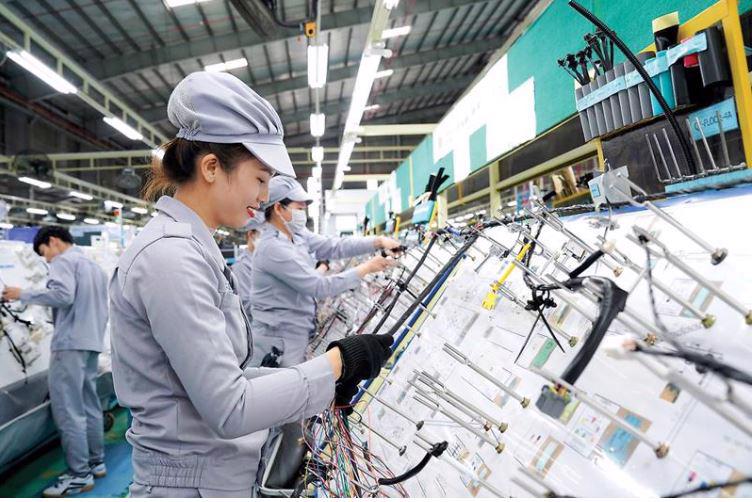To unlock all resources for double-digit growth
Vietnam needs to unlock all possible resources as it seeks to post double-digit economic growth in the years to come.

The government report presented at the opening of the 15th National Assembly’s ninth session revealed a concerning reality: there are 2,200 projects nationwide, with total capital of nearly VND5,900 trillion (equivalent to $236 billion) and a total land area of about 347,000 ha, that are “blocked” and unable to move forward. According to Associate Professor Tran Dinh Thien, former Director of the Vietnam Institute of Economics, this means “we are losing opportunities as the country’s resources are being severely wasted.”
“Bottlenecks” in the economy
In this context, solutions for investment, especially in mobilizing and allocating resources effectively, emerge as a key factor for future development. This is particularly crucial given that the goal of double-digit growth remains a major challenge amid global economic fluctuations and the trend of slowing growth in recent years. “This requires that Vietnam not only find solutions to reverse the situation of slowing growth but also to distinguish itself from other countries to break through with double-digit growth,” he emphasized.
However, when looking at the foundation to implement solutions, the Associate Professor expressed concern. The quality of Vietnam’s growth reveals many pressing issues. Investment activities, whether private, public, or FDI, have not yet achieved the anticipated results. “Private investment is weak both in quantity and structure,” he explained. “Public investment disbursement is sluggish. Vietnam’s money circulation rate is only 0.55-0.65 rounds per year, compared to the normal two rounds per year, indicating that the economy lacks circulation and appears stagnant. Meanwhile, the quality of FDI is also not high, with technology levels and spill-over effects in the domestic economy being limited.”
Looking at export and consumption drivers, domestic demand has declined since the Covid-19 pandemic, and markets have gradually contracted and weakened. While exports are a bright spot, they heavily depend on the FDI sector, which accounts for 72-75 per cent of total export value, with minimal contributions coming from the private sector. Furthermore, the number of enterprises exiting is increasingly close to the number of newly-established enterprises, which contrasts with the optimism of the previous period and also reveals many “strange” issues in the economy that need to be identified and addressed.
Unclogging capital flows
The unusual nature of this situation, according to Mr. Dau Anh Tuan, Vice Secretary-General and Director of the Legal Department at the Vietnam Chamber of Commerce and Industry (VCCI), stems from institutional bottlenecks. This is also the main belief in the private business community, as recorded in the recently-released Provincial Competitiveness Index (PCI) report from VCCI. Many projects and businesses have spent years without being able to complete investment procedures.
He added that many “gray areas” exist in the private sector. For instance, the household business sector, despite generating many jobs and revenue, has very little and fragmented statistical data. Furthermore, the participation rate of Vietnamese businesses in the supply chains of international corporations, even at the level of Tier 1 subcontractors, remains very low, showing that Vietnam’s support industries are still underdeveloped.
Therefore, Mr. Tuan believes that strategic solutions are needed to encourage private enterprises to engage more deeply in the value chains of international corporations, particularly in large markets like the US, and to encourage FDI businesses to invest more extensively in Vietnam. It is also crucial to establish foundational industry laws, such as for chemicals or energy, etc., that include specific provisions for procurement, subcontracting, and financial support, and to strengthen institutions that support Vietnamese businesses in expanding globally.
According to Dr. Can Van Luc, Member of the National Financial and Monetary Policy Advisory Council, a new approach to investment goals and solutions is needed to achieve quality and sustainable growth. Instead of focusing on quantity, growth quality should be ensured, with inflation not exceeding 5 per cent to avoid high rates that could negatively impact the macro-economy and people’s lives.
A key highlight in his proposal is the mobilization and more effective allocation of resources. To escape the middle-income trap, rather than following the sequential path recommended by the World Bank, Dr. Luc suggested that Vietnam simultaneously combine three factors: investment, technology absorption, and innovation. This approach is expected to optimize resources and reduce investment capital needs in the 2026-2045 period to about 38 per cent of GDP, compared to the 40 per cent in China’s previous model.
From a macro-economic perspective, Associate Professor Thien believes that Vietnam requires more comprehensive reform after more than 40 years of effort. The “ask-give” method, where subordinates apply for innovation and wait for approval from superiors, has become outdated and creates distortions in implementation. “This is not just a policy issue, but also a change in mindset and culture, to truly ‘break free’ and rise in an ever-changing world,” he concluded. “The future of Vietnam’s economy depends on our ability to correctly identify challenges, face them boldly, and implement strong, comprehensive reforms, where optimizing and improving investment quality plays a central role.”
We still need a real strategy for science, technology, and innovation. There are currently many strategies - on green growth, innovation, science and technology, digital transformation, and AI - but they lack focus and sufficient resources for implementation.
What is urgently needed is a national strategy for digital transformation, specific to each phase, to guide resource allocation. Market principles must be applied to science and technology, particularly in innovation.
Moreover, Vietnam’s legal system needs a more cohesive approach. The Law on Science, Technology, and Innovation should be the foundational law, with other laws built around it.
We need to reform how science and technology are managed. The Ministry of Science and Technology functions like an academic institution, overseeing national projects and allocating tasks that should be managed by scientific organizations. The central government’s budget allocation for science and technology is also inefficient and needs reform, moving towards a fund-based system for project financing.
Human resources must develop in parallel with specialized knowledge and management skills. Public awareness of science and technology should be raised alongside professional training.
Finally, organizing international scientific events in Vietnam involves securing a range of permissions, and international researchers face unnecessary hurdles, like having to apply for tourist visas to attend conferences. This system needs to be streamlined."
Associate Professor Le Bo Linh, former Vice Chairman of the National Assembly’s Committee on Science, Technology, and Environment
When discussing institutional development, we should not rely solely on economists. It is necessary to combine economists, legal experts, science and technology specialists, and cultural scholars to build a comprehensive institutional framework.
Moreover, a key driver of economic development is urbanization. By 2024, urban economies will account for more than 70 per cent of Vietnam’s GDP. According to a Politburo Resolution, Vietnam will have around 1,000 urban areas contributing about 75 per cent of GDP by 2025, and some 1,500 urban areas, accounting for 80-85 per cent of GDP, by 2030.
The country now has six centrally-governed cities and 140-150 towns and provincial cities that have been abolished and fragmented into districts. The impact of removing towns and cities on economic growth has yet to be fully explored.
In my view, as well as that of many experts, businesses, and associations, this will certainly have negative effects on the growth rate. I therefore suggest that economists, legal experts, and policymakers reassess the situation. Vietnam’s urban areas are very different now compared to the previous Politburo Resolution. Urban planning and the functions of cities have changed accordingly. Provinces now only have districts, without the dynamic centers that previously drove their development. The economic development model for urban areas has also shifted."
Mr. Nguyen Van Phuc, former Vice Chairman of the National Assembly’s Economic Committee



















